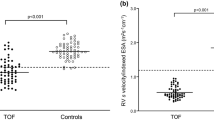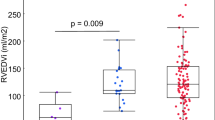Abstract
The objective of this study was quantitate diastolic dysfunction in the postoperative phase of tetralogy of Fallot (TOF) and to correlate it with the type of surgical procedure and clinical parameters. Fifty consecutive patients (mean age, 5.0 years; mean weight, 13.5 kg), operated for TOF during the period November 2004 to May 2005, were prospectively studied [infundibular resection, 23; infundibular resection and transannular patch (TAP), 19; right ventricle→pulmonary artery conduit, 8). Detailed echocardiography was done on postoperative days 3 and 9 with a focus on Doppler indices of right ventricular (RV) function, Antegrade late diastolic flow in the right ventricular outflow tract (RVOT) was taken as the marker of restrictive RV physiology. The previous parameters were correlated to the type of surgery and clinical indices of RV dysfunction. There was no mortality. Twenty-four patients showed restrictive RV physiology. This finding correlated with lower values of E/A ratio (0.98 ± 0.17 vs 1.33 ± 0.49, p < 0.002), tricuspid valve E-wave deceleration time (86.9 ± 21.7 vs 151.4 ± 152 msec, p < 0.05), index of myocardial performance (0.15 ± 0.06 vs 0.26 ± 0.09, p < 0.001), isovolumic relaxation time (19.4 ± 17 vs 39±30 msec, p < 0.009), and a higher central venous pressure (15.1 ± 1.5 vs 12.7 ± 1.9, p < 0.001). Restrictive RV physiology correlated with prolonged intensive case unit (ICU) stay (5.1 ± 3.7 vs 2.8 ± 2 days, p < 0.015), longer duration of inotropic support (108.3 ± 56.2 vs 55.5 ± 28.3 hours, p < 0.02), and higher dosage of diuretics. RV diastolic dysfunction is demonstrable by Doppler echocardiography in the first week following surgery for TOF and tends to be worse with TAP. Restrictive physiology demonstrated by RVOT pulse Doppler predicts longer duration of inotropic support, prolonged ICU stay, and higher dosage of diuretics.


Similar content being viewed by others
References
Chaturvedi RR, Shore DF, Lincoln C, et al. (1999) Acute right ventricular restrictive physiology after repair of tetralogy of Fallot: association with myocardial injury and oxidative stress. Circulation 100:1540–1547
Cullen S, Shore D, Redington A (1995) Characterization of right ventricular diastolic performance after complete repair of tetralogy of Fallot. Circulation 91:1782–1789
Del Nido PJ, Mickle DA, Wilson GJ, et al. (1987) Evidence of myocardial free radical injury during elective repair of tetralogy of Fallot. Circulation 76: 174–179
del Nido PJ, Mickle DA, Wilson GJ, et al. (1988) Inadequate myocardial protection with cold cardioplegic arrest during repair of tetralogy of Fallot. J Thorac Cardiovasc Surg 95:223–229
Di Donato RM, Jonas RA, Lang P, et al. (1991) Neonatal repair of tetralogy of Fallot with and without pulmonary atresia. J Thorac Cardiovasc Surg 101:126–137
Eidem BW, Tei C, OLeary PW, Ctta F, Seward JB (1998) Nongeometric quantitative assessment of right and left ventricular function: myocardial performance index in normal children and patients with Ebsteins anomaly. J Am Soc Echocardiogr 11:849–856
EI Rahman MYA, Abdul-Khaliq H, Vogel M, Alexi-Meskischvilli V, et al. (2002) Value of the new Doppler derived myocardial performance index for the evaluation of right and left ventricular function following repair of tetralogy of Fallot. Pediatr Cardiol 23:502–507
Fuster V, McGoon DC, Kennedy MA, Ritter DG, Kirklin JW (1980) Long term evaluation (12 to 22 years) of open heart surgery for tetralogy of Fallot. Am J Cardiol 46:635–642
Gatzoulis MA, Clarke AL, Cullen S, Newman CGH, Redington AN (1995) Right ventricular diastolic function 15 to 35 years after repair of tetralogy of Fallot:restrictive physiology predicts superior exercise performance. Circulation 91:1775–1781
Hatle L, Angelsen B (1985) Pulsed and continuous wave Doppler in diagnosis and assessment of various heart lesions In: Hatle L, Angelsen B (eds) Doppler Ultrasound in Cardiology. 2nd edn. Lea & Febiger, Philadelphia, pp 162–170
Helbing WA, Niezen RA, Le Cessie S, et al. (1996) Right ventricular diastolic function in children with pulmonary regurgitation after repair of tetralogy of Fallot: volumetric evaluation by magnetic resonance velocity mapping. J Am Coll Cardiol 28:1827–1835
Kisanuki A, Tei C, Otsuji Y, et al. (1987) Doppler echocardiographic documentation of diastolic pulmonary artery forward flow. Am J Cardiol 59:711–713
Li RK, Mickle DA, Weisel RD, et al. (1989) Effect of oxygen tension on the antioxidant enzyme activities of tetralogy of Fallot ventricular myocytes. J Mol Cell Cardiol 21:567–575
Morita K, Ihnken K, Buckberg GD, et al. (1994) Role of controlled cardiac reoxygenation in reducing nitric oxide production and cardiac oxidant damage in cyanotic infantile heart. J Clin Invest 93:2658–2666
Mulvagh S, Quinones MA, Kleiman NS, Cheirif J, Zoghbi WA (1992) Estimation of left ventricular end diastolic pressure from Doppler transmitral flow velocity in cardiac patients independent of systolic performance. J Am Coll Cardiol 20:112–119
Murphy JG, Gersh BJ, Mair DD, et al. (1993) Long term outcome in patients undergoing surgical repair for tetralogy of Fallot. N Engl J Med 329:593–599
Nogard G, Gatzoulis MA, Moraes F, et al. (1996) Relationship between type of outflow tract repair and postoperative right ventricular diastolic physiology in tetralogy of Fallot. Implications for long term outcome. Circulation 94:3276–3280
Rathore KS, Gupta N, Kapoor A, et al. (2004). Assessment of right ventricular diastolic function: does it predict postoperative course in tetralogy of Fallot. Indian Heart J 56:220–224
Redington AN, Penny D, Rigby ML, Hayes A (1992) Antegrade diastolic pulmonary arterial flow as a marker of right ventricular restriction after complete repair of pulmonary atresia with intact ventricular septum and critical pulmonary valve stenosis. Cardiol Young 2: 382–386
Tei C, Dujardin KS, Hodge DO, et al. (1996) Doppler echocardiographic index for assessment of global right ventricular function. J Am Soc Echocardiogr 9:838–847
Tei C, Ling H, Hodge DO, et al. (1995) New index of combined systolic and diastolic myocardial performance: a simple and reproducible measure of cardiac function— a study in normal and dilated cardiomyopathy. J Cardiol 26:357–366
Author information
Authors and Affiliations
Corresponding author
Rights and permissions
About this article
Cite this article
Sachdev, M., Bhagyavathy, A., Varghese, R. et al. Right Ventricular Diastolic Function After Repair of Tetralogy of Fallot. Pediatr Cardiol 27, 250–255 (2006). https://doi.org/10.1007/s00246-005-1186-y
Published:
Issue Date:
DOI: https://doi.org/10.1007/s00246-005-1186-y




